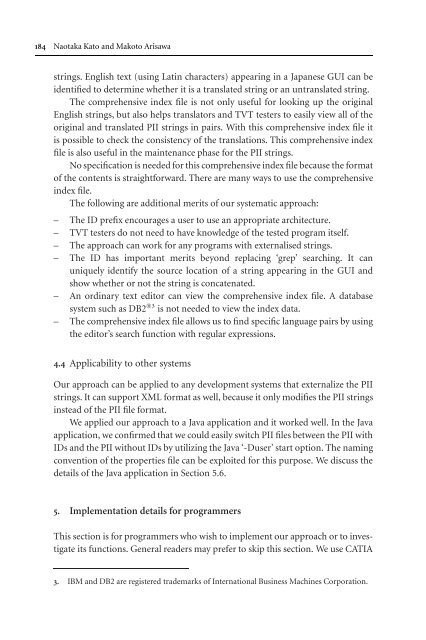Topics in Language Resources for Translation ... - ymerleksi - home
Topics in Language Resources for Translation ... - ymerleksi - home
Topics in Language Resources for Translation ... - ymerleksi - home
- No tags were found...
Create successful ePaper yourself
Turn your PDF publications into a flip-book with our unique Google optimized e-Paper software.
184 Naotaka Kato and Makoto Arisawastr<strong>in</strong>gs. English text (us<strong>in</strong>g Lat<strong>in</strong> characters) appear<strong>in</strong>g <strong>in</strong> a Japanese GUI can beidentified to determ<strong>in</strong>e whether it is a translated str<strong>in</strong>g or an untranslated str<strong>in</strong>g.The comprehensive <strong>in</strong>dex file is not only useful <strong>for</strong> look<strong>in</strong>g up the orig<strong>in</strong>alEnglish str<strong>in</strong>gs, but also helps translators and TVT testers to easily view all of theorig<strong>in</strong>al and translated PII str<strong>in</strong>gs <strong>in</strong> pairs. With this comprehensive <strong>in</strong>dex file itis possible to check the consistency of the translations. This comprehensive <strong>in</strong>dexfile is also useful <strong>in</strong> the ma<strong>in</strong>tenance phase <strong>for</strong> the PII str<strong>in</strong>gs.No specification is needed <strong>for</strong> this comprehensive <strong>in</strong>dex file because the <strong>for</strong>matof the contents is straight<strong>for</strong>ward. There are many ways to use the comprehensive<strong>in</strong>dex file.The follow<strong>in</strong>g are additional merits of our systematic approach:– The ID prefix encourages a user to use an appropriate architecture.– TVT testers do not need to have knowledge of the tested program itself.– The approach can work <strong>for</strong> any programs with externalised str<strong>in</strong>gs.– The ID has important merits beyond replac<strong>in</strong>g ‘grep’ search<strong>in</strong>g. It canuniquely identify the source location of a str<strong>in</strong>g appear<strong>in</strong>g <strong>in</strong> the GUI andshow whether or not the str<strong>in</strong>g is concatenated.– An ord<strong>in</strong>ary text editor can view the comprehensive <strong>in</strong>dex file. A databasesystem such as DB2 ®3 is not needed to view the <strong>in</strong>dex data.– The comprehensive <strong>in</strong>dex file allows us to f<strong>in</strong>d specific language pairs by us<strong>in</strong>gthe editor’s search function with regular expressions.4.4 Applicability to other systemsOur approach can be applied to any development systems that externalize the PIIstr<strong>in</strong>gs. It can support XML <strong>for</strong>mat as well, because it only modifies the PII str<strong>in</strong>gs<strong>in</strong>stead of the PII file <strong>for</strong>mat.We applied our approach to a Java application and it worked well. In the Javaapplication, we confirmed that we could easily switch PII files between the PII withIDs and the PII without IDs by utiliz<strong>in</strong>g the Java ‘-Duser’ start option. The nam<strong>in</strong>gconventionofthepropertiesfilecanbeexploited<strong>for</strong>thispurpose.Wediscussthedetails of the Java application <strong>in</strong> Section 5.6.5. Implementation details <strong>for</strong> programmersThis section is <strong>for</strong> programmers who wish to implement our approach or to <strong>in</strong>vestigateits functions. General readers may prefer to skip this section. We use CATIA3. IBM and DB2 are registered trademarks of International Bus<strong>in</strong>ess Mach<strong>in</strong>es Corporation.
















